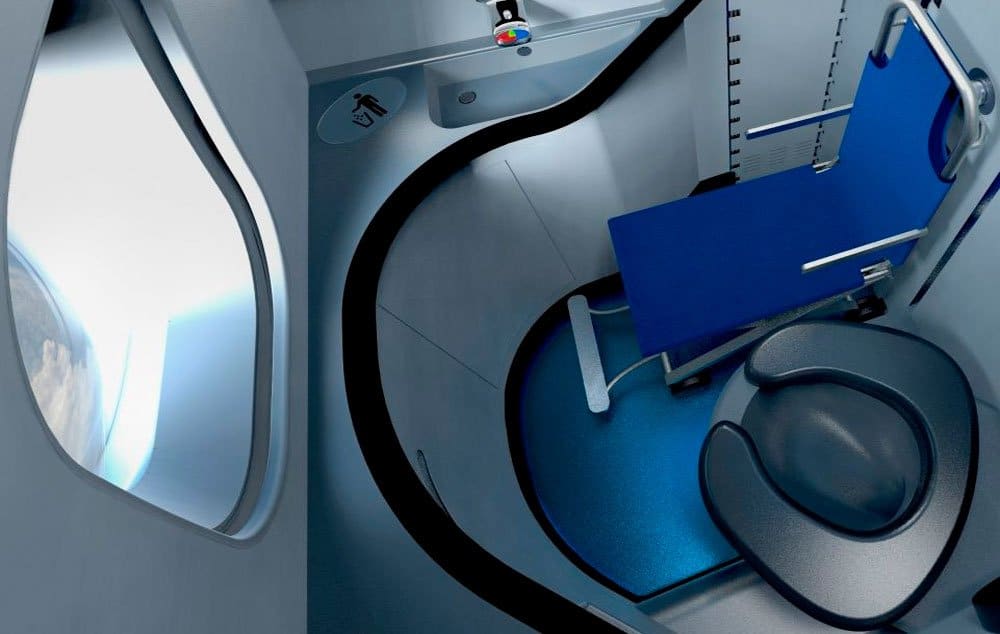Imagine that you are on a long-haul flight and for every ten rows of people there is only one screen; but that is not all. Half of the time you are forced to watch commercials, the other half of your journey they’re showing a comedy that is 20 years old. To make matters worse, you cannot move. You are in the middle seat of the middle row, trapped between two armrests. As you are wondering how other people handle this situation, lunch is served. During the meal you dropped your cutlery – twice. Not because you are clumsy but because of the extremely reduced width of your seat. In fact, the smaller the elbow room, the greater a chance of making a false move. In this case, the seat pitch is very important. Especially for those tricky moments when you are holding your tray in your left hand, trying to fold the table into an upright position so you can reach down with your right hand – still balancing the tray with the three fingers of your left hand – in order to grab your fork and knife that are hopefully lying next to your feet. Surely it has to be easier than this?
The problem of reduced space is faced by nearly every economy class passenger in the lavatory as well and in the last 25 years it seems no one has yet addressed this issue. At least I have not experienced a spacious lavatory in economy. The 2013 Crystal Cabin Award (CCA) winner of the ‘University’ category – the Big Lavatory Concept (BigLavC) – faces up to the problem of passengers getting taller over the next few decades.
Theoretically, the BigLavC (from students of the University HAW, Hamburg) could be the first aircraft lavatory on the market that is customised to the special needs of obese passengers while also fulfilling all the requirements of regular and passenger reduced mobility (PRM) lavatories. The diagonal position of the toilet is an improvement on conventional aircraft lavatories by increasing comfort and space, especially for obese passengers and wheelchair users. It is a reaction to the rising body mass indices worldwide that made the student designers think of an appropriate solution. This new toilet seat will make it safer and easier for wheelchair users to move between their wheelchair and the toilet seat. In addition, more space in the lavatory benefits all passengers.
Another CCA finalist of the same category was the Tray Table Cabinet by the students of the Delft University of Technology. This table can be opened and passengers can store their electronic devices in dedicated compartments. A foam rubber holds devices in place and prevents them from scratching. Other features include a USB-charging output, openings for headphone wires and a see-through bottom, which should help passengers keep an eye on their belongings and remind them not to leave them behind when leaving the aircraft. It might not solve the problem of reduced width, but it would make the flight more comfortable without any doubt because at least you can store your items easily. Now imagine this kind of comfort with a wider economy class seat: that is innovative passenger benefit.
Looking into the future – say 30 years from now – improved passenger comfort could consist of side panels in the cabin displaying numerous 3D images that provide a great picture of the environment, according to the CCA University finalist from the Technische Universität Dresden. This view could be supplemented by information about the surrounding region, for example, the mountains, or the ocean below, which is presented to the passenger via augmented reality. This idea would also offer an impressive flight experience. Furthermore, hybrid organic LED (OLED) layers, which convert light into energy, and small units and sensors that harvest energy via light and vibration, mean sufficient energy for wireless communication with the onboard IFE system. I am looking forward to see these kinds of positive changes in economy class over the next few years.
Source: Air Transport Publications




Ricardo, o relato feito por vc seria engraçado se não fosse triste. Me imaginei acompanhando minha filha cadeirante, não autônoma, a usar este banheiro. Nada engraçado!!Abç. Ótimas matérias.
Olá Maria,
Neste caso, é um banheiro de avião, onde o espaço é pouco e não pode se usar a cadeira própria. Mesmos sendo apertado, é acessível, então é uma boa notícia. Algumas pessoas precisam de auxílio, e dai esse banheiro seria inviável. Precisaria de melhorias. Obrigado por comentar!
Isso sim precisava ter em todos os avioes, um banheiro com acessibilidade, seria muito bom se isso virasse Lei e fosse obrigatório, vou enviar para a Mara Gabrili quem sabe.
As regras da aviação não são tão simples, afinal a aeronave não é uma propriedade de um local, como uma loja, e tem que seguir as leis locais. De qualquer maneira, quem sabe empresas brasileiras com vôos locais, podem se encaixar em leis nacionais.